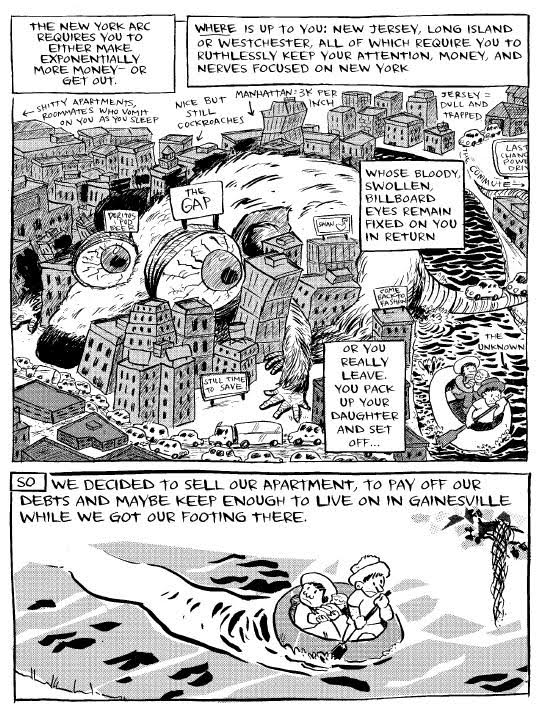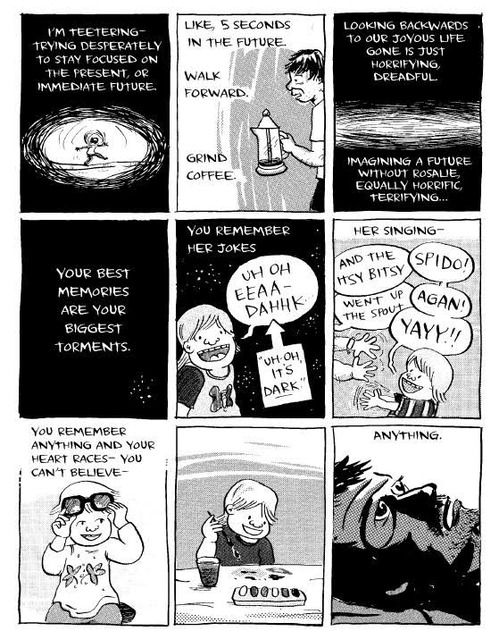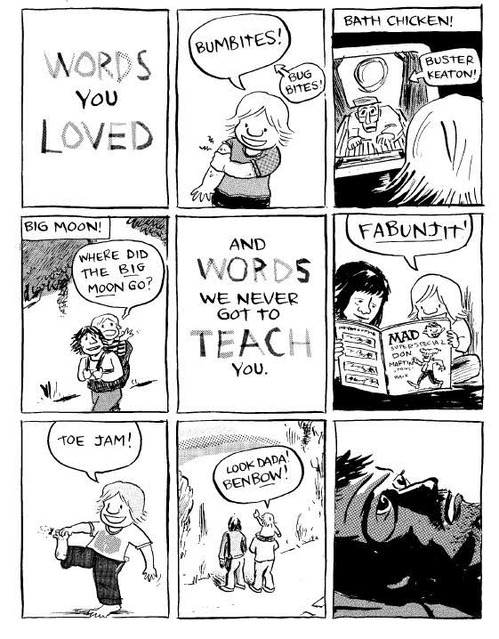
Five years ago, cartoonist and teacher Tom Hart and his wife went through every parent’s nightmare: their young daughter died suddenly for no identifiable reason. Any parent with a young child can attest to the time watching their young children sleep, checking on them, quashing fears when weird noises broadcast over the baby monitor or, even worse, no noises. They might tell themselves all the time, “Don’t worry. Your baby is fine. She’s alive. You’re doing everything you can to keep her that way.” But sometimes they’re wrong, and there’s nothing that can be done.
Hart dealt with this horrific event through comics, and Rosalie Lightning, out this week via St. Martin’s Press, is the result: a thoughtful portrait of the period shortly after a child passes away. Raw with feeling, the graphic novel shows how we work through grief—walking, thinking, guilt, confusion, somehow moving forward but slowly.It is not an easy read, but its creation was a generous act, one that is both a personal form of exorcism and a way of reaching out to the rest of the world. If you have children, it’s almost too painful to read, even as one recognizes its importance. Hart answered our questions about it via email.![]()
Paste: In some ways, Rosalie Lightning is a hard book to recommend to people. Thoughts?
Tom Hart: My first intent was to tell the breadth of horrors we experienced in our grief and trauma, but soon I realized that I didn’t want to draw it, and didn’t think anyone should be asked to read those horrors. I also realized doing the book was less about telling a story and more about deepening what healing I was able to experience. So, in the end, I think and believe the book is a hopeful book. It has very difficult passages, but the focus of the book was on the path from those terrible experiences to one of understanding. But I certainly understand if someone doesn’t want to read it. I’m staying away from the movie Rabbit Hole by one of my favorite directors, John Cameron Mitchell, for that very reason.
Paste: Or maybe only to people who have lost a child should read it? Because it creates a kind of community?
Hart: I don’t know. I have been hearing from lots of “ordinary people” who found it moving. I’m grateful they’ve read it. I think we can all be nourished by reading of other people’s grief and loss, whatever that loss be.

Rosalie Lightning Interior Art by Tom Hart
Paste: Talk to me about the process of creating it. How long did it take you to write and draw the book? When did you start?
Hart: I wrote notes incessantly for five weeks after [Rosalie died]. I knew I would have to create a book, to help these emotions find form. I stopped taking notes when they began being repetitive, but also after the final incident detailed in the book. I felt, I had been presented with all the material to heal with. Then I had to go through the work of internalizing that healing. Drawing it took roughly three and a half years. I felt I was experiencing the aftermath again. It was hard, but it was my new reality. I couldn’t deny that reality. The work of drawing it was turning my face to it to acknowledge it.
Paste: Did you write the whole thing before you started drawing?
Hart: There was an immense binder full of notes from those five weeks: thoughts, feelings, experiences. The process of creating the book was sifting through those notes and deciding what was important, and then crafting the thoughts and events and drawing it.
Paste: Did you know where you were going with it?
Hart: I knew the ending scene, and since it’s sort of a travelogue, I knew much of the structure, but every section needed different kinds of editing. I edited as I went along, creating passages from the notes.
Paste: I feel like one of the most meaningful parts of the book is where you’re offered the opportunity to let out your anger physically, but you comment that that’s what drawing/comics allow you to do. Do you think it’s always been an outlet for you in that kind of way?
Hart: I’ve always used comics to navigate the world of emotions. From the earliest days when I would copy Peanuts from the paper as a child, it was a safe space to explore emotion. My later work, as a young adult and not-so-young adult was almost always allowing a created character to emote in ways I did not in real life—to feel and react more intensely. In the case of this book, I felt like a commentator on the emotion.

Rosalie Lightning Interior Art by Tom Hart
Paste: How much revision did you do? Thinking about the amount that usually goes into a comic (the ideas, the writing, the thumbnails, the pencils, the inking, the scanning, the tweaking, etc.) and having to relive horrible moments over and over again calls to mind the kind of cognitive-behavioral therapy that’s been done with veterans who suffer from PTSD. Does going over the same material multiple times make it easier to deal with? Harder? What about doing interviews like this one?
Hart: I avoided drawing the worst experiences. It seemed unhealthy to do so. I believe most of the book is about the slow, difficult path to understanding. It’s not easy. I felt like doing the book the best I could was honoring Rosalie. I wanted to share her with the world. There were certainly passages I couldn’t get right, and didn’t force revisions of. I let them stand, because the experience was raw and I felt the record of it could be raw too. Interviews are a bit sad.
Paste: Can you tell me about your drawing process? Do you actually use zip-a-tone or is that effect applied in the computer?
Hart: Most of the first third of the book is hand-laid zip-a-tone, or shading film. It was important to use this stuff, partially because I had used it a lot as a younger artist and wanted to re-connect with it again, but also in the rawness of the experience I felt the need to draw with a knife. It can be a pretty laborious process, however, and after a while I used the computer off and on to emulate the effect. When on the computer, I tried to use a coarse, slightly clumsy tool, rather than soft, precise tools, to create the same effect of carving with a knife. So many pages are a combination of real shading film and computer tone. There are plenty that are just computer, too.
Paste: Your decision to use hand lettering for the entire book also seems significant. Yes?
Hart: It’s important for me that the letters and the drawings feel as if they’ve come from the same hand. The book had to be from my voice, and so I hand-lettered at least the first 50 pages or so. But eventually I found I was having trouble staying consistent and clean in all the text-heavy panels, so I created a font from my hand-lettering. The whole book is done that way, in fact, but still feels like hand-lettering, I hope.

